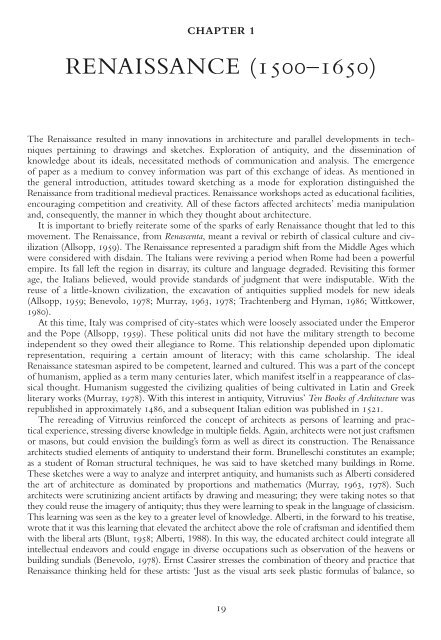Architect Drawings : A Selection of Sketches by World Famous Architects Through History
You also want an ePaper? Increase the reach of your titles
YUMPU automatically turns print PDFs into web optimized ePapers that Google loves.
CHAPTER 1<br />
RENAISSANCE (1500–1650)<br />
The Renaissance resulted in many innovations in architecture and parallel developments in techniques<br />
pertaining to drawings and sketches. Exploration <strong>of</strong> antiquity, and the dissemination <strong>of</strong><br />
knowledge about its ideals, necessitated methods <strong>of</strong> communication and analysis. The emergence<br />
<strong>of</strong> paper as a medium to convey information was part <strong>of</strong> this exchange <strong>of</strong> ideas. As mentioned in<br />
the general introduction, attitudes toward sketching as a mode for exploration distinguished the<br />
Renaissance from traditional medieval practices. Renaissance workshops acted as educational facilities,<br />
encouraging competition and creativity. All <strong>of</strong> these factors affected architects’ media manipulation<br />
and, consequently, the manner in which they thought about architecture.<br />
It is important to briefly reiterate some <strong>of</strong> the sparks <strong>of</strong> early Renaissance thought that led to this<br />
movement. The Renaissance, from Renascenta, meant a revival or rebirth <strong>of</strong> classical culture and civilization<br />
(Allsopp, 1959). The Renaissance represented a paradigm shift from the Middle Ages which<br />
were considered with disdain. The Italians were reviving a period when Rome had been a powerful<br />
empire. Its fall left the region in disarray, its culture and language degraded. Revisiting this former<br />
age, the Italians believed, would provide standards <strong>of</strong> judgment that were indisputable. With the<br />
reuse <strong>of</strong> a little-known civilization, the excavation <strong>of</strong> antiquities supplied models for new ideals<br />
(Allsopp, 1959; Benevolo, 1978; Murray, 1963, 1978; Trachtenberg and Hyman, 1986; Wittkower,<br />
1980).<br />
At this time, Italy was comprised <strong>of</strong> city-states which were loosely associated under the Emperor<br />
and the Pope (Allsopp, 1959). These political units did not have the military strength to become<br />
independent so they owed their allegiance to Rome. This relationship depended upon diplomatic<br />
representation, requiring a certain amount <strong>of</strong> literacy; with this came scholarship. The ideal<br />
Renaissance statesman aspired to be competent, learned and cultured. This was a part <strong>of</strong> the concept<br />
<strong>of</strong> humanism, applied as a term many centuries later, which manifest itself in a reappearance <strong>of</strong> classical<br />
thought. Humanism suggested the civilizing qualities <strong>of</strong> being cultivated in Latin and Greek<br />
literary works (Murray, 1978). With this interest in antiquity, Vitruvius’ Ten Books <strong>of</strong> <strong>Architect</strong>ure was<br />
republished in approximately 1486, and a subsequent Italian edition was published in 1521.<br />
The rereading <strong>of</strong> Vitruvius reinforced the concept <strong>of</strong> architects as persons <strong>of</strong> learning and practical<br />
experience, stressing diverse knowledge in multiple fields. Again, architects were not just craftsmen<br />
or masons, but could envision the building’s form as well as direct its construction. The Renaissance<br />
architects studied elements <strong>of</strong> antiquity to understand their form. Brunelleschi constitutes an example;<br />
as a student <strong>of</strong> Roman structural techniques, he was said to have sketched many buildings in Rome.<br />
These sketches were a way to analyze and interpret antiquity, and humanists such as Alberti considered<br />
the art <strong>of</strong> architecture as dominated <strong>by</strong> proportions and mathematics (Murray, 1963, 1978). Such<br />
architects were scrutinizing ancient artifacts <strong>by</strong> drawing and measuring; they were taking notes so that<br />
they could reuse the imagery <strong>of</strong> antiquity; thus they were learning to speak in the language <strong>of</strong> classicism.<br />
This learning was seen as the key to a greater level <strong>of</strong> knowledge. Alberti, in the forward to his treatise,<br />
wrote that it was this learning that elevated the architect above the role <strong>of</strong> craftsman and identified them<br />
with the liberal arts (Blunt, 1958; Alberti, 1988). In this way, the educated architect could integrate all<br />
intellectual endeavors and could engage in diverse occupations such as observation <strong>of</strong> the heavens or<br />
building sundials (Benevolo, 1978). Ernst Cassirer stresses the combination <strong>of</strong> theory and practice that<br />
Renaissance thinking held for these artists: ‘Just as the visual arts seek plastic formulas <strong>of</strong> balance, so<br />
19




